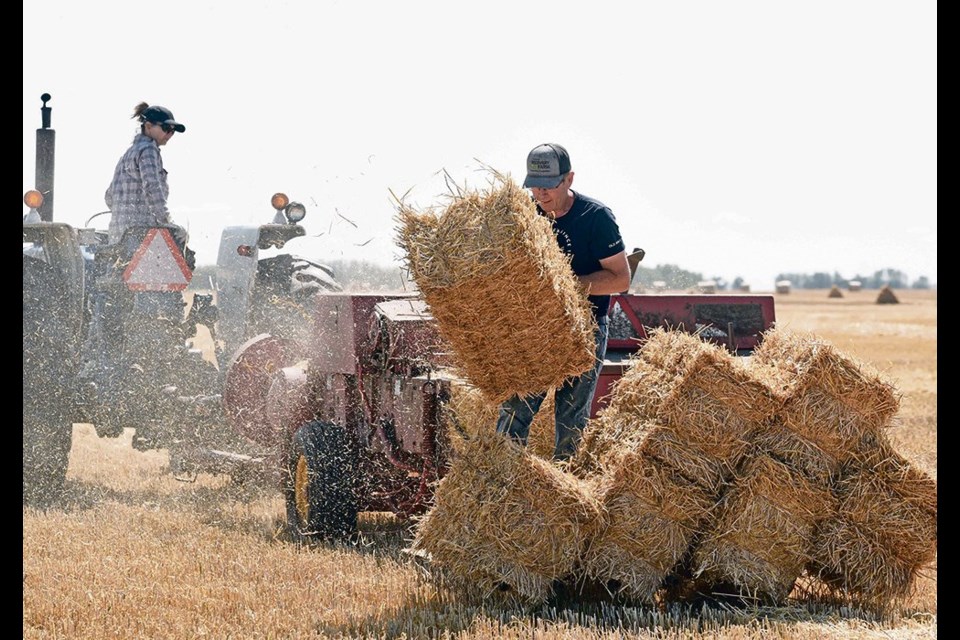QUILL LAKE, Sask. — It was a choice of getting bigger or getting more efficient.
Dwight and Tanya Odelein decided the latter in 2012 by downsizing from 3,300 acres to 2,400 so they could manage all the labour on their grain farm by themselves.
“It wasn’t easy to find hired men and Dad was starting to get a little older,” said Dwight.
“What I ended up doing is selling some land that was far away and bought most of the land that we were renting and just quit renting some other stuff.”
“At the time I considered it rolling the dice. I thought this could break me, but I had a goal and it was to get the land paid off as soon as possible,” he said.
That goal is coming to fruition.
One more year and they will be debt free, which is opening the opportunity for some creative thinking with the anticipated extra income.
“I am now in a position that I could buy more land,” he said with a laugh. “It’s a lot simpler. Zero regrets. If I had to do it all over again, I would do the same thing.”
With less financial pressure comes the conversation about retirement.
“We can seed our next crop debt free so let’s see. We don’t have to do it anymore,” he said.
Their two adult daughters, Sabrina and Sydney, are pursuing off-farm careers. However, Dwight and Tanya are not sure what the future holds.
“We want them to pick a career or path that truly makes them happy and don’t want them to go down a road because they feel obligated. We’ve left the door wide open for them. It’s their choice. There’s no pressure from us for them to come back and farm, but if they choose to that’s great,” said Tanya.
Added Dwight: “As far as any sort of a transition, some people might think this farm is too small to carry on. I don’t really see why. With no debt, if one or both of our girls wanted to come back and farm, they would have a base to start from. Time will tell.”
Like many prairie grain farms, a portion of their land is saline. For many years, they used to seed their annuals (canola, wheat, barley, peas and oats) through a 55-acre salty stretch of ground.
Throughout the history of the three-generation farm, they knew this area could not produce great yields and money spent on inputs was wasted. Since 2014, they have grown forage on it.
“That’s the best fix because to seed an acre of canola, just your cash costs are $250 per acre. So you don’t need an economics degree to figure out that if you’re only getting a return of $200 on this, you’re going backwards,” he said.
“We second cut some of the alfalfa this year during the drought. These are soft core bales that averaged about three bales per acre. So that’s 2,400 pounds per acre on this land that was taken out of production because it was not profitable to grain farm.
“This is high value stuff in a drought so conservatively, at 10 cents a pound, I’m getting $240 an acre. … Seed cost is probably $20 or $30 an acre and that’s a one-time thing,” he said.
The neighbours have noticed, especially in the last few years, and the Odeleins have fielded questions from fellow farmers about seed blend and when to seed.
About six years ago they even pulled Dwight’s grandfather’s old Massey 124 square baler out of the bush.
It hadn’t made a bale for at least 20 years, but after some chain oil and a grease job, it got to work again.
“Just started baling some stuff up and horse people really liked it. We had some just straight brome grass, no dust in it. Made a bunch of straw one year. Fairly hot commodities, square bales,” Dwight said.
Soil tests have also confirmed that the saline areas have three times the nutrients compared to field averages.
“It comes as no surprise because you are putting nutrients in these saline spots year after year. And if the crop is growing 10, 20, or 30 percent of the rest of the field, there’s 70, 80, 90 percent of the nutrients that aren’t getting used.” he said.
The Odeleins recently completed a restoration of their old barn that has become an attractive landmark.
There’s no mistaking it.
“Look for the big red barn,” is how Dwight gives directions for grain haulers and other visitors to the home quarter. The classic hip-roof barn punctuates the big blue sky like an exclamation point.
“That’s actually the third barn that’s been sitting there. The first one was built by my grandfather in 1944. I don’t know if it was even a full calendar year old and lightning struck it and it burned. It then got rebuilt in 1945 and then we did a total renovation in 2018.”
The barn was lifted and a new concrete foundation poured with in-floor heating. The old walls were rebuilt using insulating concrete forms. The original loft and cedar-shingled roof were placed on top.
“It was more for restoration and then just a place to work. People ask me questions about that and I always joke. I say my cows are going to be comfortable.”
The livestock are long gone, but with a beer fridge and big stereo, it’s become something of a man cave, he said.
Tanya concurs: “Oh yeah, it’s a man cave. I will go out and do some wood working, but that’s mostly his little sanctuary.”






